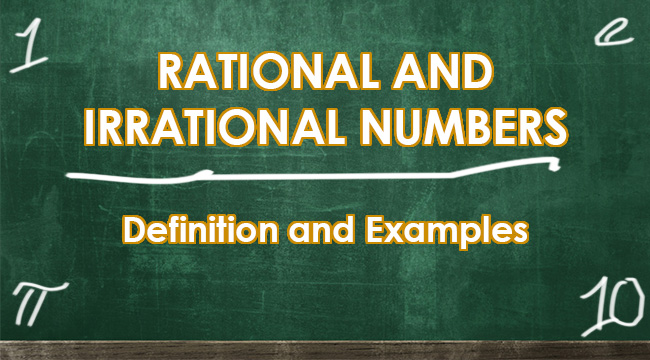Rational & Irrational Numbers Meaning: Definition And Their Examples
RATIONAL AND IRRATIONAL NUMBERS- In this topic, we will discuss about the definition of rational and irrational numbers and their examples.
In the Math subject, you will encounter this particular lesson about numbers, specifically, the definition of a rational number and an irrational number.
Thus, we ask ourselves,, what is possibly the difference between the two, aside from the name, of course. This topic will provide you with the needed knowledge.

Let us begin with the definition of a rational number.
Rational Number
Rational numbers are part of a whole expressed as a fraction, decimal or a percentage. The term rational is derived from the term “ratio” due to the reason that you can write these numbers in ratio form. For example, 5 is a rational number, because you can write 5 as 5:1; or 7/8 can be written as 7:8.
To put it simply, rational numbers can be whole numbers, fractions, decimals and yes, even negatives.
Here are some of the examples:
Whole numbers : 1,2,3,4,5,6,7,8,9,10…….
Negative numbers: -12, -56, -88, -92, -101
Fractions : 1/5, 2/4, 17/20, 5/5, 10/28
Decimals : .333, .54, .26267, .8888889, .12
Irrational Number
Irrational numbers, on the contrary, are numbers that cannot be written as a ratio of two integers.
Here are some examples:
- Square root of 2 ( √ 2) – It is irrational because it is a square root of a non-perfect square unlike the rest.
- Pi (π) – Pi has no accurate decimal equivalent since it is never-ending, thus, counted as an irrational number. Its value is 3.1415926535… and so on.
- Euler’s number (e) – Similar to Pi, Euler’s number has no accurate decimal equivalent. It’s value is 2.718281828… and so on.
- Golden ratio ( φ ) – The value of the golden ratio is 1.618033988…. and so on.
READ ALSO: ADJECTIVE WORD ORDER: Rules in Arranging Adjectives & Examples
